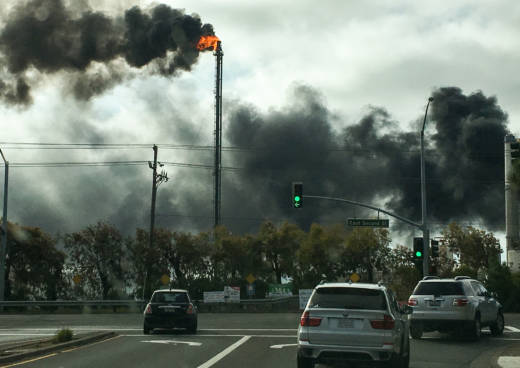The Valero refinery released a total of nearly 25,000 pounds of sulfur dioxide on May 6 and 7, the company's report said. On May 14, it released close to 8,000 pounds of the gas, the company's report said.
To put those numbers in perspective, air district statistics show that the Valero refinery released an estimated total of 13,800 pounds of sulfur dioxide in 2016 and 15,400 pounds in 2015 through flaring. From 2004 through 2016, flaring releases have ranged from a low of 13,400 in 2009 to a high of 277,000 pounds in 2008. The facility's average annual sulfur dioxide flaring release during the period was 76,000 pounds.
In its report, Valero said the refinery also emitted 350 pounds of carbonyl sulfide, a highly toxic and extremely flammable gas, between May 12 and May 15.
Valero's report said its monitoring did not show an increase in ambient sulfur dioxide levels outside the refinery site, a sprawling facility at the northern end of the Benicia-Martinez Bridge. The company said exposure to the gas was limited to "persons solely within the site or sites on which the facility is located."
The document did not give details about the hour-to-hour release of sulfur dioxide or the concentration of the gas at the refinery during the episode. The report also did not indicate whether workers at the facility were treated for exposure.
The new details about the refinery releases prompted an angry response from one environmental group that has monitored the facility.
"It's absolutely unacceptable that this dirty refinery spewed dangerous gases into the air we breathe for two full weeks," said Hollin Kretzmann, a staff attorney at the Center for Biological Diversity's Climate Law Institute, in an email.
"These reckless air pollution releases are too frequent and too dangerous to continue," said Kretzmann, who also reviewed the data.
Valero's report will be a part of the investigation into the outage by local air regulators, according to Tom Flannigan, a spokesman for the Bay Area Air Quality Management District.
But first, he said, the agency needs to confirm the numbers are correct.
"We review this data and information related to the flaring event for accuracy," Flannigan said in an email. "Combined with other data from air monitors in and around the facility, we can create a comprehensive view of the incident."
The air district, which has issued notices of violation to the refinery, also needs to look at data on wind speed and direction during the flaring episode, Flannigan said.
During the first three days of the incident, May 5-7, when sulfur dioxide releases were highest, the area experienced winds that veered from northwest to southwest. Sustained winds at two weather stations on the Martinez shoreline during the first day and a half of the episode ranged up to 30 mph, with gusts of up to 34 mph.
The report covers the refinery's releases through May 18, but the facility had trouble restarting even after that.
At the end of May, local air regulators opened a new investigation into the facility after it sent another round of black smoke and toxic gas into the air.
The last releases took place on June 1, according to reports posted on a hazardous materials database managed by the California Office of Emergency Services.
Last week, a Valero official said the refinery had finally restarted and for the first time explained what was behind the weeks-long flaring.
"Due to the abrupt nature of the emergency shutdown, the refinery was unable to go through the systematic process we follow for planned shutdowns that allows the refinery to minimize emissions during shutdown and restart," company spokeswoman Lillian Riojas said in an email on Thursday.
The oil company continues to blame PG&E for the outage.
The San Francisco-based utility has said the electrical failure was triggered by an "inadvertent operation" to protect power circuits. PG&E has hired a third party engineering firm, Exponent, to review the cause.
